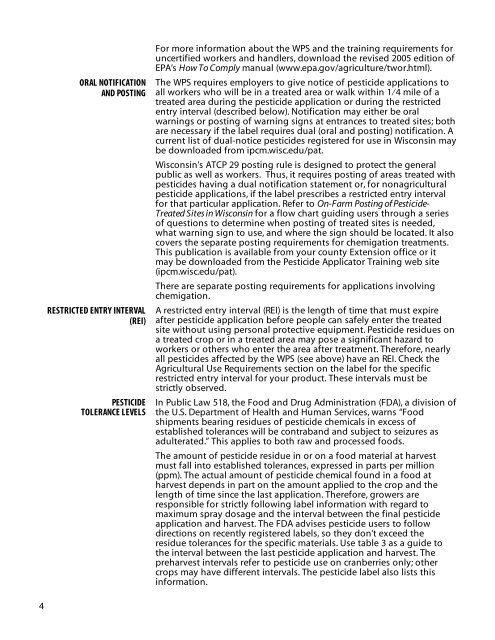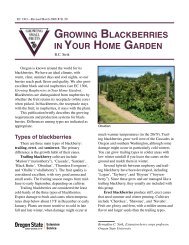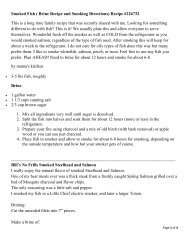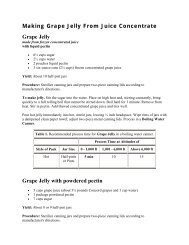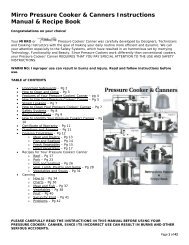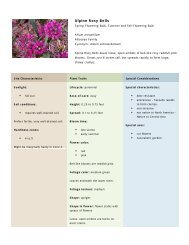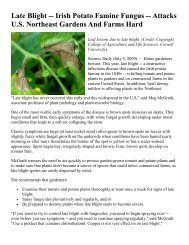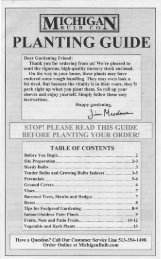Strawberry and Raspberry Pest Management in Wisconsin
Strawberry and Raspberry Pest Management in Wisconsin
Strawberry and Raspberry Pest Management in Wisconsin
Create successful ePaper yourself
Turn your PDF publications into a flip-book with our unique Google optimized e-Paper software.
4<br />
ORAL NOTIFICATION<br />
AND POSTING<br />
RESTRICTED ENTRY INTERVAL<br />
(REI)<br />
PESTICIDE<br />
TOLERANCE LEVELS<br />
For more <strong>in</strong>formation about the WPS <strong>and</strong> the tra<strong>in</strong><strong>in</strong>g requirements for<br />
uncertified workers <strong>and</strong> h<strong>and</strong>lers, download the revised 2005 edition of<br />
EPA’s How To Comply manual (www.epa.gov/agriculture/twor.html).<br />
The WPS requires employers to give notice of pesticide applications to<br />
all workers who will be <strong>in</strong> a treated area or walk with<strong>in</strong> 1⁄4 mile of a<br />
treated area dur<strong>in</strong>g the pesticide application or dur<strong>in</strong>g the restricted<br />
entry <strong>in</strong>terval (described below). Notification may either be oral<br />
warn<strong>in</strong>gs or post<strong>in</strong>g of warn<strong>in</strong>g signs at entrances to treated sites; both<br />
are necessary if the label requires dual (oral <strong>and</strong> post<strong>in</strong>g) notification. A<br />
current list of dual-notice pesticides registered for use <strong>in</strong> Wiscons<strong>in</strong> may<br />
be downloaded from ipcm.wisc.edu/pat.<br />
Wiscons<strong>in</strong>’s ATCP 29 post<strong>in</strong>g rule is designed to protect the general<br />
public as well as workers. Thus, it requires post<strong>in</strong>g of areas treated with<br />
pesticides hav<strong>in</strong>g a dual notification statement or, for nonagricultural<br />
pesticide applications, if the label prescribes a restricted entry <strong>in</strong>terval<br />
for that particular application. Refer to On-Farm Post<strong>in</strong>g of <strong>Pest</strong>icide-<br />
Treated Sites <strong>in</strong> Wiscons<strong>in</strong> for a flow chart guid<strong>in</strong>g users through a series<br />
of questions to determ<strong>in</strong>e when post<strong>in</strong>g of treated sites is needed,<br />
what warn<strong>in</strong>g sign to use, <strong>and</strong> where the sign should be located. It also<br />
covers the separate post<strong>in</strong>g requirements for chemigation treatments.<br />
This publication is available from your county Extension office or it<br />
may be downloaded from the <strong>Pest</strong>icide Applicator Tra<strong>in</strong><strong>in</strong>g web site<br />
(ipcm.wisc.edu/pat).<br />
There are separate post<strong>in</strong>g requirements for applications <strong>in</strong>volv<strong>in</strong>g<br />
chemigation.<br />
A restricted entry <strong>in</strong>terval (REI) is the length of time that must expire<br />
after pesticide application before people can safely enter the treated<br />
site without us<strong>in</strong>g personal protective equipment. <strong>Pest</strong>icide residues on<br />
a treated crop or <strong>in</strong> a treated area may pose a significant hazard to<br />
workers or others who enter the area after treatment. Therefore, nearly<br />
all pesticides affected by the WPS (see above) have an REI. Check the<br />
Agricultural Use Requirements section on the label for the specific<br />
restricted entry <strong>in</strong>terval for your product. These <strong>in</strong>tervals must be<br />
strictly observed.<br />
In Public Law 518, the Food <strong>and</strong> Drug Adm<strong>in</strong>istration (FDA), a division of<br />
the U.S. Department of Health <strong>and</strong> Human Services, warns “Food<br />
shipments bear<strong>in</strong>g residues of pesticide chemicals <strong>in</strong> excess of<br />
established tolerances will be contrab<strong>and</strong> <strong>and</strong> subject to seizures as<br />
adulterated.” This applies to both raw <strong>and</strong> processed foods.<br />
The amount of pesticide residue <strong>in</strong> or on a food material at harvest<br />
must fall <strong>in</strong>to established tolerances, expressed <strong>in</strong> parts per million<br />
(ppm). The actual amount of pesticide chemical found <strong>in</strong> a food at<br />
harvest depends <strong>in</strong> part on the amount applied to the crop <strong>and</strong> the<br />
length of time s<strong>in</strong>ce the last application. Therefore, growers are<br />
responsible for strictly follow<strong>in</strong>g label <strong>in</strong>formation with regard to<br />
maximum spray dosage <strong>and</strong> the <strong>in</strong>terval between the f<strong>in</strong>al pesticide<br />
application <strong>and</strong> harvest. The FDA advises pesticide users to follow<br />
directions on recently registered labels, so they don’t exceed the<br />
residue tolerances for the specific materials. Use table 3 as a guide to<br />
the <strong>in</strong>terval between the last pesticide application <strong>and</strong> harvest. The<br />
preharvest <strong>in</strong>tervals refer to pesticide use on cranberries only; other<br />
crops may have different <strong>in</strong>tervals. The pesticide label also lists this<br />
<strong>in</strong>formation.


